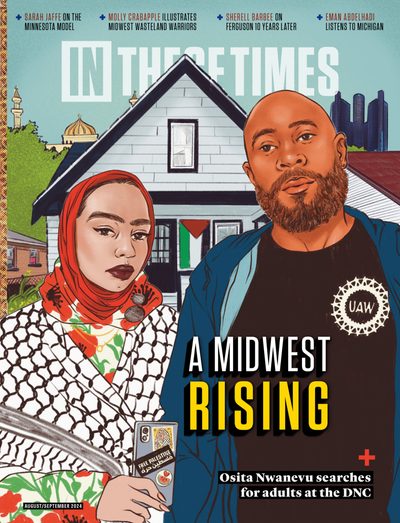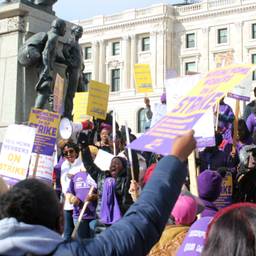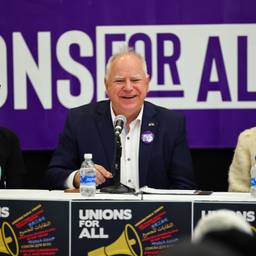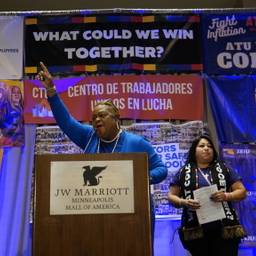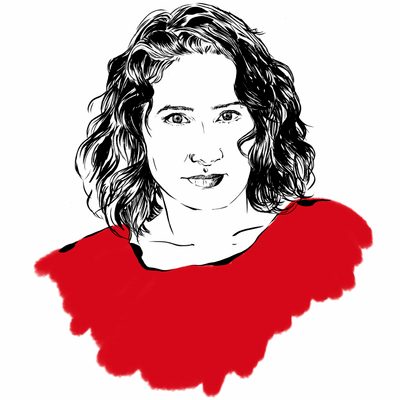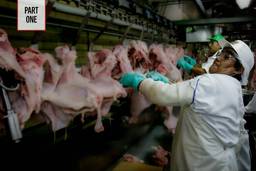The Minnesota Model Is Transforming Organizing as We Know It
“We can win more together than we can on our own.”
Sarah Jaffe

NOTE: This piece was written before Minnesota Gov. Tim Walz was picked by Kamala Harris to be her running mate against former President Donald Trump and his running mate, JD Vance, in the upcoming November election.
We do the work that makes the city work,” read one of the picket signs borne by the workers who take care of the public parks in Minneapolis. They had been on strike for seven days in July when they attended a meeting of the Minneapolis Park and Recreation Board, dressed in their bright orange LiUNA! shirts.
The workers confronted the board about its refusal to return to bargaining, its demands in the “last, best and final” offer, over their working conditions and low pay. When the board tried to end public comment, AJ Lange, business manager for LIUNA Local 363, representing the Laborers’ International Union of North America, refused to let the comment period end, taking the microphone and inviting his members to continue sharing their stories.
“We’re not going to stand for your silence anymore,” Lange said. “Do you think it’s enough to just listen? Because you’re complicit. … This is more important than your rules, order, your time clock. Our livelihoods are on the line.”
Lange told me the next day it was a “significant act of disruption,” but more important was the daily support from the community and organized labor. More than 200 full-time and 100 seasonal parks workers are among 1,000 members of Local 363, which is also part of a broad alignment of tens of thousands of workers, tenants and community members organizing to change political power dynamics in the Twin Cities — some for more than a decade.
As this article went to press, the workers got a tentative agreement that includes raises of more than 10% plus cost-of-living adjustments; they killed the “poison pills” that the board had wanted, including restrictions on union stewards.
“Our fight became a focal point for ongoing worker struggles across the state. When we stood up to demand dignity, respect and fair pay, the public support and solidarity of organized labor was overwhelming,” Lange said about securing the agreement. “When we refused to accept union busting tactics and harmful anti worker contract language, others saw their own struggle reflected in ours. Our fight is for the workers and for the people, and that’s why the community had our backs.”
Many of the people I spoke to call it the “Minnesota Model.” It’s a commitment to the principles that “we can win more together than we can on our own” and that the working class has many needs that are not being met — at work, but also at home, in parks, in schools, in hospitals. It has had resounding effects at the ballot box, but mostly builds power away from it.
It’s a process that has built up over years, as a small group stacked up wins and more and more groups joined them; as new organizations were seeded and grew in immigrant communities and disparate neighborhoods; when in 2020, after George Floyd was killed, residents rebelled at ongoing police violence and kicked off a wave of protest that shook the world. The Minnesota Model has yielded gain after gain: free school meals and driver’s licenses for undocumented immigrants; getting Amazon to negotiate with workers for the first time; a $15 minimum wage (with proposals to bring it up to $20); so many union contracts it’s hard to count, for janitors and tenants and teachers. Minneapolis sent Ilhan Omar to Congress, Keith Ellison became state attorney general, and Minnesota residents voted in a Democratic trifecta to run state government.
But the real power of the Minnesota Model is the solidarity it fosters in the streets.
Lange and Local 363 are new to the alignment, and the July strike cemented their feeling of being part of something big. In March, as part of a broad week of action across a network of unions, social justice groups and community organizations, 400 of Local 363’s members from the Public Works department secured a historic raise of 30% over three years. This time, Lange explained, hitting the picket lines with neighbors and leaders of the Minneapolis Federation of Educators and SEIU Local 26, among so many others, has been different.
“Now,” Lange said, “everybody is getting plugged into my fight specifically.”
Cat Salonek, who works with Tending the Soil — a more formal coalition within the broader alignment that includes Centro de Trabajadores Unidos en la Lucha (CTUL), Inquilinxs Unidxs por Justicia/United Renters for Justice (IX), New Justice Project (NJP), SEIU Local 26 and Unidos MN — offered that “saying ‘I know that I’m going to get mine and you’re going to have my back until I get mine’ is what makes [bigger wins] possible, because we’re willing to fight for each other, even if it means that another industry is going to get their win first.”
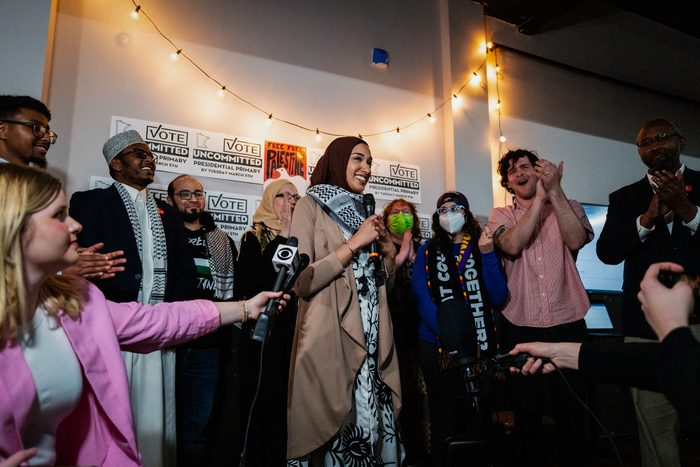
Nat Bradt has worked in the service industry in Minneapolis for 16 years, and 12 of those have been with First Avenue, the iconic music company and venue made famous by Prince. “When I got hired, it was my dream job … but, pretty quickly, I began to realize that there were a lot of not so ideal conditions at work.” Scheduling was inconsistent and pay rates low, so she joined the union drive with UNITE HERE Local 17. In November, the company agreed to voluntarily recognize the union.
For Bradt, it’s been thrilling. “I remember very well just standing around the corner with my coworkers, getting ready to walk in with our petition and just how new that feeling was to be like, okay, we’ve done all this work and now we are going to show the company that we have this power.” She looked around with pride at the other organizing drives in the city, the broader movement that she’s part of. “It’s really amazing to stand together with other workers throughout the city as they come into their collective power.”
In Uptown, Iain Knopp-Schwyn works at Kim’s, the flagship restaurant of award-winning chef Ann Kim. When we spoke in July, he and his coworkers had also just voted to join Local 17. The restaurant has a service surcharge in lieu of tips, which means, Knopp-Schwyn explained, that service staff rely on consistent hours. Restaurant work, he said, doesn’t mean workers don’t need consistency and good wages.
It’s been “wonderful,” Knopp-Schwyn said, to see “all of this growth of labor and of community activism in Minneapolis.”
“And so we’re all really excited to win a contract that’s going to make us feel more secure.”
It’s impossible to say where and exactly when the Minnesota Model got its start. We might date the beginning to around 2011, post-financial crisis, when SEIU’s nationwide Fight for a Fair Economy seeded Minnesotans for a Fair Economy, which included the nascent CTUL. At the time, CTUL codirector Merle Payne told me, CTUL was organizing retail janitors. Members decided to hold a hunger strike.
“We were two staff taking on one of the biggest corporations in the state,” Payne said. “But we were a part of Minnesotans for a Fair Economy. And that meant that we essentially had a staff of six people from all of these different organizations that, every morning at 6 o’clock, would wake up with us and sit and plan for two hours … so it really got baked into our DNA as an organization: We cannot win what we want to win by ourselves. We have to be a part of a bigger ecosystem.”
CTUL now has about two dozen staff and those retail janitors have a union, part of SEIU Local 26. They helped win a $15 minimum wage and anchor the fight for paid sick and safe time.
Brahim Kone is secretary-treasurer at Local 26 and started as a janitor. Originally from the Ivory Coast, he came to Minneapolis in 2001. “As a French speaker, the janitorial work was, for me, a hiding place where I don’t have to confront the language,” he said. But the abuse and mistreatment he and his coworkers faced drove him to action. He’d been part of the student movement at home, and he brought that organizing history to the union. He became a steward and threw himself into union work, becoming an executive board member and then union staff before running for his current position in 2020, alongside president Greg Nammacher.
“Our members are majority people of color, brown and Black, and majority women,” Kone said. “We learn not to separate [issues] because our members are the ones who are struggling with housing, they are struggling with immigration, they are struggling with low incomes. So the thing that we do all the time is analyze who is in this fight with us. You’re going to always find somebody who is fighting for something that we care about.”
This core principle, that workers don’t lead single-issue lives, informs all of the Minnesota Model organizations. That understanding leads them to the kind of power analysis that looks beyond the shop floor and elected officials— though both are important — to line up and lift up allies, and then really use the power they have.
That means strikes, Kone said: Disruption is where power is.
“Our intention last time was: We had the bus drivers involved, we have the teachers involved, we have security, janitorial,” Kone explained. “And so imagine one day, for example, where there’s no bus that’s running in Minnesota, where the janitors are not going to work, the security guards are not going to work. The teachers saying, no, we’re not working today.”
They might have enemies, he said, but their alliance is stronger. And that alliance changed the face of Minnesota politics, bringing about the Democratic trifecta that passed policies statewide that were goals for members of the alignment. One of those legislative wins was $9 million for the Rise Up Center, a workforce development and training hub to include offices for Local 26, Unidos MN, NJP, UFCW Local 663 and others. Local 17, CTUL and IX are also part of the project.
One of the alignment’s key recent demands from workers has been local labor standards boards, which would regulate conditions in an entire industry. “It creates a mechanism for workers [and] nonunion workers to collectively bargain with the city and with the corporations all at the same time,” explained Salonek of Tending the Soil. A labor standards board could, for example, set wage and sick time and healthcare standards for everyone downtown.
The standards boards, Payne said, were inspired in part by a strategic planning session that CTUL held four years back. It had taken seven years to win the retail janitorial campaign, he said, and “it kind of feels like we’re dropping a pebble in an ocean” when “on the one hand, you have workers who are making minimum wage and scraping to get by, but are building the future economy of the state. And on the other hand, you see these companies that are just swimming in wealth.” They wanted to scale up.
Members decided to “get to the root causes of why wage theft, why poverty wages, why all of this exists, and pull it out by the roots.” That meant coming face to face with the richest 0.1% who pull the strings of the economy, which led to the construction industry, to downtown and then to the idea of setting standards across industries.
Rod Adams, executive director of NJP, organizes among the Twin Cities’ Black working class. He noted Minnesota is justly getting credit for lots of progressive policies, but the state has a ways to go. Right now he’s working on raising the minimum wage and applying the “ban the box” policy — which prevents employers from asking about felony convictions on job applications, passed in Minnesota in 2013 — to housing applications. He’s also involved in the labor standards board work.
“Access to things like paid leave, access to quality healthcare, access to living wage jobs for people of color — it’s still an issue,” Adams said.
Minnesota remains deeply segregated, a fact the world was reminded of in 2020 when the George Floyd uprising rocked Minneapolis and the country. Marcia Howard, now president of the teacher chapter of the Minneapolis Federation of Teachers and Educational Support Professionals (MFT) was in what is now called George Floyd Square (or sometimes the Free State of George Floyd) daily for months, helping to hold down the autonomous zone, and continues to organize there. Darnella Frazier, who filmed Floyd’s death, had been Howard’s student. CTUL and IX, Howard noted, have offices just down the block, and they opened those offices to protesters when they were under fire.
“We understand that we are our neighbor’s keeper,” Howard said.
There are also pressures to split groups apart, Howard noted: “The powers that be want us to be individuals. The powers that be want us to think that there’s only enough for some of us,” and funders create a model of scarcity that sets organizations against one another. But MFT (and the national American Federation of Teachers) supported Howard as she stayed in the square. “It is an organization of neighbors and militant leftists and just everyday folks who are just sick and tired of being sick and tired under the regime of the Third Precinct of the Minneapolis Police Department.”
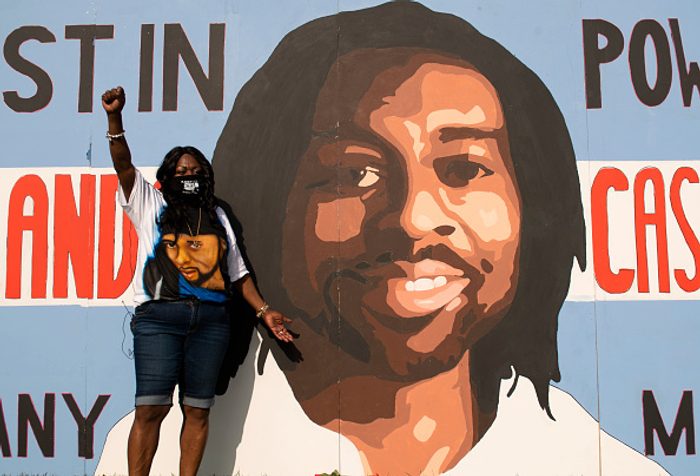
At the time, Howard was a rank-and-file teacher, not thinking about union leadership. But the new union president, Greta Callahan, came to meet Howard in the square and asked her to speak as the union prepared for its 2022 strike. MFT and the St. Paul Federation of Educators (SPFE) coordinated their strike votes for a potential two-city strike; SPFE had been on strike in recent years and reached a settlement, but MFT went out on its first in 52 years — for nearly three weeks.
“While the bargaining team and our leaders were inside bargaining and doing mediation, I was outside on the truck in front of the governor’s mansion, in front of the state Capitol, on avenues and boulevards with our members,” Howard said. Teachers who had been marching for Black lives were suddenly marching for themselves and their students. “We could talk about having safe and stable schools for kids. And what brings that is having safe and stable employees, because our working conditions were their learning conditions — and we were hemorrhaging educators, especially veteran educators.”
SPFE wins helped inspire MFT to fight, but so did the movement in the streets.
“Black folks in the United States are treated like the sacrificial lamb and the goose that laid the golden egg,” Howard said. “We are whatever you need us to be.” That’s why, she said, Black liberation had to be part of labor struggles. “Labor has to be brave in this moment, especially in this moment. And not just brave. They have to be moral. And I’m not saying that in this sort of piety sense. I’m saying the idea of justice and equity, that is what’s going to sustain us,” she said. “I believe this is a resurgence of the labor movement, and it’s inextricably tied to the movement for Black lives, for trans rights, for LGBT acceptance. Black liberation is for the liberation of everybody.”
One example is that of the Minnesota’s free school lunch bill, championed by Valerie Castile. Castile’s son, Philando, had been a beloved cafeteria worker when he was killed by a police officer in a St. Paul suburb in 2016. The outpouring of love from the community — including from students whose lunch bills Philando paid from his own pocket — led Castile to fundraise for school lunch debt and ultimately back the bill that ensured it was a thing of the past.
“His mom worked tirelessly to get that passed,” Howard said. “And yet I really want people to understand that it shouldn’t have taken that much work. … We have an abundance in this state.”
Arianna Anderson rented a home from HavenBrook Homes in 2014 and immediately noticed problems. “We were having major issues like lead, mold, leaks, no heat in the wintertime,” she said, adding that it was the way her landlord did nothing to fix them that led her to call the number on a flyer IX brought to her door in 2020, when they were organizing HavenBrook residents.
“Come to find out that a lot of people were experiencing some of the things that I was and were unable to resolve those issues,” she said. “So me, as a mother of five, I decided to join the campaign.”
HavenBrook is a subsidiary of Progress Residential, a massive private equity-backed company with some 90,000 U.S. properties. In North Minneapolis, where the city’s Black population is concentrated, Anderson said, “We’re kind of kept in a box.” When she learned how many of these homes her landlord owned — 250 — she was angry. “A company that’s the biggest landlord in America, and they’re worth billions of dollars, and they can’t even give us safe and dignified housing.”
Minnesota Attorney General Keith Ellison got involved and sent staffers to Anderson’s home to see the conditions. After years of organizing and holding protests, the company was ordered to pay restitution (the details of which are still being worked out). Anderson and the other tenants — who had reported holes in their roofs, rats, flooding, electrical problems — were moved into better homes.
“One of the scariest things was fighting a billion-dollar landlord while you were housed by them,” Anderson said. “That was really scary because it was their word over mine. And one STEPHEN MATUREN/AFP VIA GETTY IMAGES of the things that empowered me to keep going was the community and organizing and meeting up with each other and finding people that were having those same struggles and those same fears, and just giving each other strength.”
Rachel Jones was also a HavenBrook tenant; she moved into her apartment still pregnant and leaving an abusive relationship, and the settlement has also helped her move into a new apartment at below-market rent. But it’s still expensive, and so she’s gotten involved with IX’s campaign for social housing — truly public, democratically controlled homes for any who need them. “I can’t go back in time and change my situation, but I hope that I can go forward and help someone else’s situation,” she said.
“IX itself is an incredibly inclusive organization, and the goal isn’t, ‘Let’s get some better housing for some people.’ The goal is all-inclusive, democratic, dignified housing for all,” Jones continued.
IX is also looking to organize renters with another major landlord in the city and to coordinate more with tenant unions outside of Minnesota. They’re also in the final steps of officially buying the buildings that are in the Sky Without Limits cooperative, the fruit of one of their prior campaigns.
When many people think of progressive politics, they think elections. But electoral work is a tiny part of the equation for most of the organizations I spoke with. They’re more concerned with building their bases and networking those bases to strengthen communities — often, the ones most taken for granted by public officials. Many of their members are immigrants who cannot vote, for example, while others struggle to see the point in electoral politics when it doesn’t seem to change their lives.
Electoral wins are only “the beginning of the fight,” according to CTUL’s Payne. Often, elected officials don’t like it when protests, strikes and actions continue once they have won, but Payne’s attitude toward them is, “We are creating the space for you to do what we asked you, what we voted you into office to do.”

To Kone and SEIU Local 26, politicians who want to be called allies need to prove themselves. The union, he said, takes the process very seriously. Recently, the SEIU Minnesota state council rescinded its endorsement of state legislator Ruth Richardson, who also served as the CEO of Planned Parenthood North Central States (PPNCS). The Planned Parenthood workers had unionized with SEIU Healthcare Minnesota and Iowa, and the union faced a fierce anti-union campaign from PPNCS leadership.
Endorsements are only one way to get legislation passed, Payne noted. During the fight to pass “ban the box” and increase the minimum wage, CTUL was organizing retail janitors at Target, headquartered in Minnesota. The negotiations would be going well and then, Payne said, the rug would be pulled out.
“We pulled together a coalition of different organizations that had different demands on Target,” Payne said. “We got Target to agree around banning the box. We got them to move around the retail janitors. Very quickly … Minnesota ban[ned] the box because, suddenly, Target sees it in their interest to not fight it.”
Some of the organizations I spoke with are considering getting more involved in elections and are creating 501©4 organizations to do so, and building a shared electoral platform across Tending the Soil. “Everyone has their own protocols, legal allowances and missions to deal with when it comes to elections,” the group’s Salonek said.
Before, the main vehicle for affecting elections had been “good organizing, base-building of people with a shared class experience, making the same or similar demands across industries.” A shared electoral platform could take that to the next level.
“If we’re working with our allies, we can make it a little more whole-person focused,” said Jen Arnold, codirector of IX. A platform could give candidates ready-made issues to run on and allow for more accountability if those candidates don’t follow through. The goal is to “make our issues the biggest issues in elections over and above the candidates.” Fundamentally, it is always about bringing power back to the members.
For public sector workers, who are ultimately negotiating with public officials, the question of elections is central but complicated. The parks workers fight got ugly, AJ Lange said, in part because the elected parks commissioners seemed unwilling to rein in their superintendent.
But it’s not just the parks board that doesn’t live up to its progressive exterior, Rod Adams said. “Our governor is looked to as a potential 2028 candidate, but he is super beholden to corporations.”
Minnesota’s Democratic Party is technically the Democratic-Farmer-Labor Party, or DFL, but it’s not always clear whether it cares about labor or farmers. The first session of the trifecta, Adams noted, saw a lot of progressive policies passed — legalizing marijuana, protecting abortion access, gun restrictions — but the second session was quieter. “We are sitting in a progressive litmus test of how far can we do things for working families before corporations, Republicans and swing voters say, ‘We don’t like this,’” Adams said.
The pushback could come before some people even feel the impact of those policies — the people who are NJP’s base, and CTUL and IX and Local 26’s. Minnesota had a huge turnout to vote “uncommitted” in the primaries — 19%. Adams noted the Right is literally calling for revolution, while the people in their crosshairs aren’t getting much from the supposed Left.
“We have a decision to make,” he said. “Do we reject the politics of the old and transform our political system and the way which we talk to people and organize … or do we continue with the status quo?”
The main question for the Minnesota Model is how to build everyday democracy. How do you build it in the workplace and the apartment complex and the ballot box? How do you democratize a parks board meeting, or a city block, or even a police precinct?
“It’s politicizing to fight your landlord,” Arnold said. “And then it’s also politicizing to feel like ‘I can make a difference in the city’s politics.’ And what’s really cool and kind of unique about Minnesota is that, now, even though undocumented folks can’t vote, they can participate in caucusing.” That means that Democratic party conventions can include people like her members.
Co-enforcement is a big piece of the plan going forward, Salonek said. “We pass a really great policy for workers, earned sick and safe time or minimum wage or whatever it may be. And then our organizations get the contract to enforce that. We’ll go out and survey workers about their pay, and we’re the ones that get to do the trainings if a violation has been found. That creates more base building opportunities to bring workers together who’ve had similar experiences of exploitation.”
They have to be careful not to let it slide into privatization, dumping the work back onto their organizations, though. “It is a balancing act, and the way that I see it is that tax money is being used to go back into workers’ hands to hold the corporations accountable that have exploited them,” she said.
Such a process does more than just bring in funding. It builds democratic muscle among the working class and expands the organizing skills they already built to get the policy in the first place. “Those exact skills and know-how are brought to the workers, and they have an access to their peers in a way that city investigators will not, because they will always be interpreted as police or as an authority that doesn’t come from within the community,” Salonek said.
That collaborative spirit is inculcated from the start. “That we can win more together than we can win apart through the base, all the way up to that leadership so that whenever a new leader does come in, they’re part of a culture that prioritizes winning more than they could win alone,” Salonek said.
The work they have done is in a way like the painstaking process of setting up dominos: it takes a long time, but then you tip one over and all of the rest fall in a row. “When all this pain is gone and you get the time to rest and reflect and you see all what we have done, that’s priceless,” Kone said.
After all, as Payne noted, “There’s not something different about Minnesota. The difference is that there have been a core group of leaders that had a vision, that drove stuff in the right direction together to build stuff together. … The Minnesota Model can happen anywhere, it’s a matter of leadership and really leaning in to build ecosystems and work together.”
“The Minnesota Model is patience, the Minnesota Model is solidarity, the Minnesota Model is action,” Kone concluded. “The Minnesota Model is the future.”
Sarah Jaffe is a writer and reporter living in New Orleans and on the road. She is the author of Work Won’t Love You Back: How Devotion To Our Jobs Keeps Us Exploited, Exhausted, and Alone; Necessary Trouble: Americans in Revolt, and her latest book is From the Ashes: Grief and Revolution in a World on Fire, all from Bold Type Books. Her journalism covers the politics of power, from the workplace to the streets, and her writing has been published in The Nation, The Washington Post, The Guardian, The New Republic, the New York Review of Books, and many other outlets. She is a columnist at The Progressive and In These Times. She also co-hosts the Belabored podcast, with Michelle Chen, covering today’s labor movement, and Heart Reacts, with Craig Gent, an advice podcast for the collapse of late capitalism. Sarah has been a waitress, a bicycle mechanic, and a social media consultant, cleaned up trash and scooped ice cream and explained Soviet communism to middle schoolers. Journalism pays better than some of these. You can follow her on Twitter @sarahljaffe.
